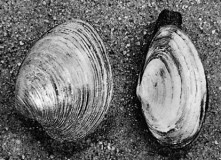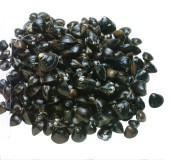Clam
http://www.100md.com
《e Natural Health Center》
 |
 |
 |
Seafood
Clam
Latin:
Bivalve mollusk
Origin:
Clam in general refers to any member of the invertebrate class Bivalvia--mollusks with a bivalved shell (i.e., one with two separate sections). More than 12,000 species of bivalves are known, of which about 500 live in freshwater; the others occur in all seas. Bivalves usually live on sandy or muddy bottoms.
, 百拇医药
True clams, in the strict sense, are bivalves with equal shells closed by two adductor muscles situated at opposite ends of the shell, and with a powerful, muscular, burrowing foot.
Clams characteristically lie buried from just beneath the surface to depths of about 0.6 m. They rarely travel over the bottom as do some other bivalves. Most clams inhabit shallow waters, in which they are generally protected from wave action by the surrounding bottom. One species of abra clam (Abra profundorum), however, has been taken in the Pacific Ocean at a depth of more than 4,800 m.
, 百拇医药
Clams draw in and expel water for respiration and feeding through two tubes, the siphons, or "neck." The water is impelled by the beating of millions of cilia (hairlike structures) on the gills. Other cilia strain food from the incurrent water and transport it, entangled in mucus, to the mouth. Eggs are usually shed by the female into the water and fertilized there by sperm released from the male. The eggs develop into larvae that swim briefly before settling permanently on the bottom. A few clams, such as the gem clam (Gemma), have internal fertilization and development.
, 百拇医药
The size of clams ranges from 0.1 mm in Condylocardia to 1.2 m across in the giant clam (Tridacna gigas) of the Pacific and Indian oceans.
Clams have a mild, briny taste and a more or less chewy texture, depending on size and variety.
Live clams are available year-round, but they don't stay fresh as long during the summer, when they are spawning.
Properties:
, 百拇医药
Clam meat: Sweet and salty in flavor, cold in nature, it is related to the liver and stomach channels.
Clam shell: Salty in flavor, slightly warm in nature.
Functions:
Clears away heat and induces diuresis, detoxifies and relieves carbuncles.
Applications:
1. For thirst and polyuria (too much urine, a characteristic of diabetes):
, 百拇医药
Simmer clam flesh and consume it and the broth. It can be served twice daily or as a regular side dish.
2. For tuberculosis:
Prepare 100 g clam flesh, 50 g Chinese chives (hotbed ones). Stir-fry both in oil and serve as a side dish. It can be used as a regular dish.
3. For yin deficiency with dry cough, sore throat, hot palms and soles and night sweats:
Boil 100 g clam flesh, 30 g lily, 50 g Chinese yam. After done, add monosodium glutamate and serve.
, http://www.100md.com
4. For beauty purposes:
Pearl powder is commonly used as cosmetic for external use. In the Qing imperial palace, pearl powder was used by Empress Dowager Cixi as an important cosmetic.
Dosage and Administration:
Clams can be prepared in different ways, but before cooking, scrub clams under running water with a stiff brush.
To shuck clams, first put them in the freezer for five minutes to loosen their hold. Work over an empty bowl to collect any clam juice. Hold the clam in your hand with the shell hinge toward your palm, and insert a thin, dull knife (never a sharp kitchen knife) between the shell. Work the knife around so you can cut through the hinge. Open the shell and slide the knife between the clam and the top shell. Then detach the clam by sliding the knife between it and the bottom shell.
, 百拇医药
Steaming: Place 0.6 cm water (wine and seasoning optional; lemon makes an excellent seasoning) in the bottom of a large pan. Add clams in the shell. Bring water to a boil, reduce heat, and simmer until shells open (four to five minutes). Throw away any clams that don't open, or cook them until they do. Serve clams in bowls along with the cooking broth.
Grilling: Place cleaned and scrubbed clams in the shell directly on the grill, about 10 to 15 cm above prepared coals or fire. Turn after two minutes. Cook until shells open slightly, about four minutes.
, http://www.100md.com
Pan frying: Heat the frying pan, then add butter or oil. Add clam meat and saute until brown, two to three minutes.
Deep frying: Pour oil into a wok or deep fryer; it should be at least 3.8 cm deep, and the cooker should be less than half full of oil. Heat oil to 190° C, using a thermometer to monitor temperature. If using geoducks, cut into 2.5-cm pieces. Dip clam meat in batter, drain, and then slip pieces into hot oil. Cook until brown, about two to three minutes.
, 百拇医药
Can also be applied topically when crushed into powder.
Quality clams are easy to recognize. Fresh clams smell clean, like the ocean. The shells of most live clams are tightly closed. Some clams with protruding siphons cannot close up when out of the water, but the siphon should pull in somewhat when touched.
Most clams available commercially have been cleaned, but if you dig your own, you must remove the sand and grit from inside the shell. Either use salt water or make enough saltwater brine (1 cup of salt per 3 litres of water) to cover clams. Soak clams in salt water in the refrigerator several hours or overnight. This is particularly important for clams with protruding siphons. For tightly closed hard-shell clams, it may be enough to simply scrub the shells to remove grit.
, http://www.100md.com
After cleaning, refrigerate clams in a bowl, covered with a damp towel. Clams will keep for up to a week, but should be cooked as soon as possible.
To freeze, remove clam meat from shells and wrap it in freezer paper or plastic; then over-wrap with a plastic bag. Store for up to two months.
To thaw, place frozen clams in the refrigerator overnight. To thaw faster, wrap clams in waterproof plastic and place in a sink with cool running water, allowing about 30 minutes per 450 grams. For fastest thawing, use the defrost cycle of your microwave, letting clams rest between brief zaps (as one minute defrost to one minute resting).
, 百拇医药
Cautions on Use:
Clams should not be cooked for too long.
Allergy to foods and food additives is a common cause of hives, especially in chronic cases. Shellfish like clams are among the many foods most often reported to trigger hives.
Some people with liver cirrhosis (widespread disruption of normal liver structure by fibrosis and the formation of regenerative nodules that is caused by any of various chronic progressive conditions affecting the liver) and impaired bile flow (such as in Wilson's disease or PBC) can have an excess amount of copper accumulate in the liver. If laboratory tests confirm copper excess, most doctors would recommend avoiding shellfish, which is rich in copper, along with recommending medical treatment to reduce copper stores.
, http://www.100md.com
Reference Materials:
Toxic or Side Effects:
Modern Researches:
Clam contains protein, fat, sugar, calcium, vitamins A, B1 and B2. Clam is an excellent source of vitamin B12 (42 mcg), and iron (11.9 mg). Its shell and pearl contain large amounts of calcium carbonate and magnesium carbonate.
Clams are not a source of omega-3 fatty acids., 百拇医药